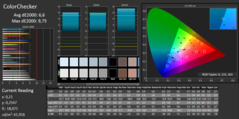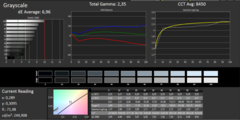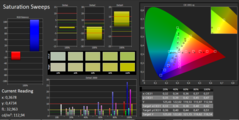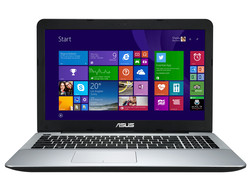Asus F555LJ (GeForce 920M) Notebook Review

For the original German review, see here.
Within its F555/X555 laptop series, Asus offers affordable 15.6-inch all-rounder notebooks - we have already reviewed a few models in the past. Our review notebook looks interesting because it features a latest-generation Broadwell CPU and GeForce 900M series GPU. Our particular example comes with a Core i3-5010U processor and a GeForce 920M graphics card. This lower-end middle-class configuration should offer significantly improved performance compared to the predecessors. We have already reviewed two other siblings - the X555LD-XX283H and the F555LD-XX243H, which are equipped with previous generation hardware. This should make it quite easy to determine the possible advantages and disadvantages of the new CPUs and GPUs.
The F555LJ's main competitions are affordable all-rounder notebooks from other manufacturers like Acer's Aspire E5-571G, HP's Pavilion 15 and Lenovo's Z50.
Since the models in the F555/X555 all feature identical construction, we will omit the case, connectivity, input devices, display, and speaker sections. Please check the review of the Asus X555LD-XX283H for more details.
Display
The F555LJ comes with the same panel type as the Asus X555LD-XX283H. Our measurements show some differences, but this is a pretty normal occurrence: even panels within the same series are never one hundred percent identical.
| |||||||||||||||||||||||||
Brightness Distribution: 86 %
Center on Battery: 201 cd/m²
Contrast: 790:1 (Black: 0.31 cd/m²)
ΔE ColorChecker Calman: 6.6 | ∀{0.5-29.43 Ø4.79}
ΔE Greyscale Calman: 6.96 | ∀{0.09-98 Ø5}
66% sRGB (Argyll 1.6.3 3D)
43% AdobeRGB 1998 (Argyll 1.6.3 3D)
45.95% AdobeRGB 1998 (Argyll 3D)
66.1% sRGB (Argyll 3D)
44.34% Display P3 (Argyll 3D)
Gamma: 2.35
CCT: 8450 K
| Asus F555LJ-XX110H 1366x768 | Asus X555LD-XX283H 1366x768 | HP Pavilion 15-p151ng 1920x1080 | Acer Aspire E5-571G-520X 1920x1080 | Toshiba Satellite S50-B-12U 1366x768 | HP 355 G2 1366x768 | Lenovo IdeaPad Z50-75 1366x768 | |
|---|---|---|---|---|---|---|---|
| Display | 3% | 22% | 25% | -10% | -21% | -2% | |
| Display P3 Coverage (%) | 44.34 | 45.54 3% | 54.8 24% | 55.9 26% | 39.83 -10% | 35.1 -21% | 43.66 -2% |
| sRGB Coverage (%) | 66.1 | 67.8 3% | 78.8 19% | 80.7 22% | 59.9 -9% | 52.9 -20% | 65 -2% |
| AdobeRGB 1998 Coverage (%) | 45.95 | 47.22 3% | 56.5 23% | 57.8 26% | 41.15 -10% | 36.26 -21% | 45.15 -2% |
| Screen | -6% | -44% | -40% | -27% | -77% | -12% | |
| Brightness middle (cd/m²) | 245 | 188 -23% | 293 20% | 223 -9% | 203 -17% | 211 -14% | 229 -7% |
| Brightness (cd/m²) | 236 | 167 -29% | 280 19% | 226 -4% | 208 -12% | 213 -10% | 211 -11% |
| Brightness Distribution (%) | 86 | 74 -14% | 83 -3% | 91 6% | 88 2% | 78 -9% | 90 5% |
| Black Level * (cd/m²) | 0.31 | 0.34 -10% | 0.8 -158% | 0.77 -148% | 0.41 -32% | 1.21 -290% | 0.34 -10% |
| Contrast (:1) | 790 | 553 -30% | 366 -54% | 290 -63% | 495 -37% | 174 -78% | 674 -15% |
| Colorchecker dE 2000 * | 6.6 | 5.4 18% | 13.19 -100% | 10.13 -53% | 9.93 -50% | 13.28 -101% | 8.27 -25% |
| Greyscale dE 2000 * | 6.96 | 4.39 37% | 13.41 -93% | 11.68 -68% | 10.84 -56% | 13.28 -91% | 9.01 -29% |
| Gamma | 2.35 94% | 2.16 102% | 3.38 65% | 2.92 75% | 2.24 98% | 2.52 87% | 2.28 96% |
| CCT | 8450 77% | 7246 90% | 13185 49% | 12592 52% | 11605 56% | 17759 37% | 10614 61% |
| Color Space (Percent of AdobeRGB 1998) (%) | 43 | 43.7 2% | 51 19% | 52 21% | 38 -12% | 34 -21% | 41.4 -4% |
| Color Space (Percent of sRGB) (%) | 66 | ||||||
| Total Average (Program / Settings) | -2% /
-4% | -11% /
-26% | -8% /
-22% | -19% /
-22% | -49% /
-61% | -7% /
-9% |
* ... smaller is better
Performance
The models within the F555/X555 series of 15.6-inch notebooks are true all-rounders and as such offer enough performance for everyday tasks as well as games. Our review notebook can be purchased for about 550 Euros (~$610). Asus sells many other, differently equipped configurations as well.
Processor
The F555LJ comes equipped with a dual-core Core i3-5010U - the Broadwell successor of the Core i3-4010U CPU. The new CPU boasts a core frequency that is higher by 400 MHz (2.1 GHz vs. 1.7 GHz). Neither processor features Turbo Boost. The higher clock speed in combination with the architecture improvements result in a much higher performance compared to the predecessor. Our tests show a gain of 20 to 30%, regardless of whether the notebook was plugged in or running on battery. AMD cannot really compete with Intel here and both the A4 and A6 series of APUs have significantly lower CPU performance.
| Sunspider - 1.0 Total Score (sort by value) | |
| Asus F555LJ-XX110H | |
| Asus F555LD-XX243H | |
| Asus X555LD-XX283H | |
| HP Pavilion 15-p151ng | |
| Acer Aspire E5-571G-520X | |
| HP 350 G1 | |
| HP 355 G2 | |
| Mozilla Kraken 1.1 - Total (sort by value) | |
| Asus F555LJ-XX110H | |
| Asus F555LD-XX243H | |
| Asus X555LD-XX283H | |
| HP Pavilion 15-p151ng | |
| Acer Aspire E5-571G-520X | |
| HP 355 G2 | |
| Octane V2 - Total Score (sort by value) | |
| Asus F555LJ-XX110H | |
| Asus F555LD-XX243H | |
| Asus X555LD-XX283H | |
| HP Pavilion 15-p151ng | |
| Acer Aspire E5-571G-520X | |
| HP 355 G2 | |
| Peacekeeper - --- (sort by value) | |
| Asus F555LJ-XX110H | |
| Asus F555LD-XX243H | |
| Asus X555LD-XX283H | |
| HP Pavilion 15-p151ng | |
| Acer Aspire E5-571G-520X | |
| HP 355 G2 | |
* ... smaller is better
System Performance
The system runs smoothly and lag-free. We did not encounter any problems during our time with the notebook. The results of the PCMark benchmark tests are decent. Just like the CPU results, the PCMark benchmark scores are significantly higher than those of the Haswell predecessors. The system performance can be improved by swapping the existing platter-based hard drive for a solid-state disk.
| PCMark 7 Score | 2574 points | |
| PCMark 8 Home Score Accelerated v2 | 2972 points | |
| PCMark 8 Creative Score Accelerated v2 | 3102 points | |
| PCMark 8 Work Score Accelerated v2 | 3613 points | |
Help | ||
| PCMark 7 - Score (sort by value) | |
| Asus F555LJ-XX110H | |
| Asus X555LD-XX283H | |
| HP Pavilion 15-p151ng | |
| Acer Aspire E5-571G-520X | |
| Toshiba Satellite S50-B-12U | |
| Lenovo IdeaPad Z50-75 | |
Storage Devices
The F555LJ comes with a Travelstar Z5K500 hard drive with a capacity of 500 GB and a rotational speed of 5400 rpm. The drive is divided into a 186 GB OS partition and a 263 GB data partition. The transfer rates are not out of the ordinary and appropriate for 5400-rpm drives.
Graphics Card
With the GeForce 920M, Asus has incorporated Nvidia's latest entry-level GPU. This particular model is the successor to the GeForce 820M graphics card. From a technical standpoint, the two GPUs do not have much in common: the 920M is based on the Kepler while the 830M is based on the Fermi architecture. Both feature nearly identical clock speeds of 954 vs. 955 MHz, although it would be foolish to assume identical performance as well, since the architecture is quite different. The benchmark tests bring clarity and show the superiority of the 920M: the new GPU scores 20 to 30% higher than the predecessor running the 3DMark benchmarks. This is on par with the performance of an AMD Radeon R5 M255 GPU.
In addition to the GeForce GPU, the notebook also features an integrated HD Graphics 5500. The two GPUs allow for graphics switching (Optimus). The Intel GPU is used for less demanding tasks and while the notebook is running on battery. The GeForce GPU handles demanding applications like games. The switch between the graphics units happens automatically, so the user does not have to intervene, although they have the option to do so at any time.
| 3DMark 03 Standard | 23055 points | |
| 3DMark 05 Standard | 14564 points | |
| 3DMark 06 Standard Score | 8626 points | |
| 3DMark Vantage P Result | 5656 points | |
| 3DMark 11 Performance | 1766 points | |
| 3DMark Ice Storm Standard Score | 53548 points | |
| 3DMark Cloud Gate Standard Score | 5142 points | |
| 3DMark Fire Strike Score | 1045 points | |
Help | ||
| 3DMark 06 - 1280x1024 Standard Score AA:0x AF:0x (sort by value) | |
| Asus F555LJ-XX110H | |
| HP Pavilion 15-p151ng | |
| Acer Aspire E5-571G-520X | |
| HP 355 G2 | |
| 3DMark Vantage - 1280x1024 P Result (sort by value) | |
| Asus F555LJ-XX110H | |
| HP 355 G2 | |
Gaming Performance
The combination of CPU and GPU offers enough performance for many games at the native screen resolution and lower to medium quality settings. Games that are not resource-intensive allow for even higher settings. The latest games often require a reduction of the resolution as well as the quality to produce high enough frame rates. Demanding games like "The Witcher 3" remain unplayable regardless of the settings.
Although there has been an improvement of 20 to 30% in the performance of F555LJ in the 3DMark benchmarks compared to that of its Haswell siblings, the difference as far as games are concerned is much lower, at about 10 to 20%. Lower resolution/quality settings lead to a more pronounced advantage. Although the F555LJ's results of the 3DMark benchmarks put it on par with notebooks equipped with the Radeon R7 M255, the system actually handles gaming better than the AMD competition.
| low | med. | high | ultra | |
|---|---|---|---|---|
| The Elder Scrolls V: Skyrim (2011) | 54.6 | 36.9 | 27 | 13.9 |
| Diablo III (2012) | 111.2 | 72.7 | 59.6 | 37.2 |
| Hitman: Absolution (2012) | 42.5 | 28.7 | 13.6 | 5.3 |
| Tomb Raider (2013) | 84.6 | 42.9 | 25.4 | 11.8 |
| StarCraft II: Heart of the Swarm (2013) | 159.9 | 74.8 | 40.3 | 14.8 |
| BioShock Infinite (2013) | 64.1 | 35.3 | 29.6 | 10.5 |
| Thief (2014) | 25 | 14.9 | 12.3 | 6 |
| GRID: Autosport (2014) | 128.5 | 51.9 | 24.1 | 12.5 |
| Risen 3: Titan Lords (2014) | 46.8 | 26.4 | 11 | 9.1 |
| Fifa 15 (2014) | 71.6 | 55.2 | 34.1 | |
| Middle-earth: Shadow of Mordor (2014) | 29.9 | 19.2 | 10.4 | 7.6 |
| Alien: Isolation (2014) | 47 | 30.5 | 17.1 | 11.2 |
| The Evil Within (2014) | 26.5 | 17.7 | 10.1 | |
| F1 2014 (2014) | 76 | 67 | 36 | 21 |
| Far Cry 4 (2014) | 32.8 | 21.6 | 9 | 8.3 |
| Dragon Age: Inquisition (2014) | 32 | 26.8 | 14.9 | 9.9 |
| The Crew (2014) | 28.6 | 22.2 | 11 | 8.3 |
| Evolve (2015) | 25.4 | 18.8 | 9.8 | 7.1 |
| Battlefield Hardline (2015) | 40.9 | 28.7 | 12.7 | 7.3 |
| Dirt Rally (2015) | 136.6 | 33.2 | 16.9 | 12.5 |
| The Witcher 3 (2015) | 18.4 | 10.9 | 6.3 | 3.8 |
| F1 2014 | |
| 1366x768 Medium Preset (sort by value) | |
| Asus F555LJ-XX110H | |
| Toshiba Satellite S50-B-12U | |
| HP 350 G1 | |
| HP 355 G2 | |
| Lenovo IdeaPad Z50-75 | |
| 1920x1080 High Preset (sort by value) | |
| Asus F555LJ-XX110H | |
| HP 350 G1 | |
| HP 355 G2 | |
| Lenovo IdeaPad Z50-75 | |
| Far Cry 4 | |
| 1024x768 Low Graphics Quality (sort by value) | |
| Asus F555LJ-XX110H | |
| Asus X555LD-XX283H | |
| 1366x768 Medium Graphics Quality (sort by value) | |
| Asus F555LJ-XX110H | |
| Asus X555LD-XX283H | |
| StarCraft II: Heart of the Swarm | |
| 1366x768 Medium (sort by value) | |
| Asus F555LJ-XX110H | |
| HP 355 G2 | |
| 1366x768 High AA:on (sort by value) | |
| Asus F555LJ-XX110H | |
| HP 355 G2 | |
| Diablo III | |
| 1366x768 Medium / low (sort by value) | |
| Asus F555LJ-XX110H | |
| HP 355 G2 | |
| Lenovo IdeaPad Z50-75 | |
| 1366x768 High AA:on (sort by value) | |
| Asus F555LJ-XX110H | |
| HP 355 G2 | |
| Lenovo IdeaPad Z50-75 | |
| The Elder Scrolls V: Skyrim | |
| 1366x768 Medium Preset AA:4x (sort by value) | |
| Asus F555LJ-XX110H | |
| HP 355 G2 | |
| 1366x768 High Preset AA:8x AF:8x (sort by value) | |
| Asus F555LJ-XX110H | |
| HP 355 G2 | |
| Hitman: Absolution | |
| 1024x768 Lowest Preset (sort by value) | |
| Asus F555LJ-XX110H | |
| HP 355 G2 | |
| 1366x768 Medium Preset AF:2x (sort by value) | |
| Asus F555LJ-XX110H | |
| HP 355 G2 | |
Emissions & Energy
System Noise
The F555LJ is not a very noisy notebook. While idling, the fan is always on, but runs at a low speed. Under load, the fan speed increases. We measured 41.8 dB(A) during the stress test - an acceptable value. This in turn means that the system is less noisy than its Haswell siblings.
Noise level
| Idle |
| 32 / 32.4 / 33.6 dB(A) |
| HDD |
| 32.6 dB(A) |
| DVD |
| 36 / dB(A) |
| Load |
| 38.3 / 41.8 dB(A) |
 | ||
30 dB silent 40 dB(A) audible 50 dB(A) loud |
||
min: | ||
| Asus F555LJ-XX110H 920M/5010U | Asus X555LD-XX283H 820M/4010U | HP Pavilion 15-p151ng R7 M260/A10-5745M | Acer Aspire E5-571G-520X 840M/5200U | Toshiba Satellite S50-B-12U R7 M260/4210U | HP 355 G2 R5 M240/A8-6410 | Lenovo IdeaPad Z50-75 R6 M255DX/A10-7300 | |
|---|---|---|---|---|---|---|---|
| Noise | -0% | -8% | 4% | 0% | -6% | 3% | |
| Idle Minimum * (dB) | 32 | 31.4 2% | 32.7 -2% | 31.7 1% | 33.2 -4% | 32.1 -0% | |
| Idle Average * (dB) | 32.4 | 32 1% | 32.2 1% | 32.7 -1% | 32.5 -0% | 33.2 -2% | 32.4 -0% |
| Idle Maximum * (dB) | 33.6 | 32.3 4% | 32.2 4% | 32.7 3% | 33.1 1% | 33.8 -1% | 32.4 4% |
| Load Average * (dB) | 38.3 | 41.9 -9% | 45.3 -18% | 34.2 11% | 37.2 3% | 42 -10% | 36.9 4% |
| Load Maximum * (dB) | 41.8 | 42 -0% | 49.4 -18% | 37.8 10% | 43.6 -4% | 46.5 -11% | 38.4 8% |
* ... smaller is better
Temperature
The chassis of the F555LJ does not really get warm. During the stress test (Prime95 and FurMark running in parallel for at least one hour), we recorded a maximum temperature of 37.8 degrees C (~100 °F) in one area near the fan. Often, low temperatures are the result of throttling of either the CPU or GPU; the F555LJ does not fall into this category, as both the CPU (2.1 GHz) and the GPU (954 MHz) operated at their full speed. When we ran the stress test with the notebook on battery power, the results were similar, although the processor occasionally dipped down to 500 MHz about 10 minutes into the test.
(+) The maximum temperature on the upper side is 29.2 °C / 85 F, compared to the average of 36.9 °C / 98 F, ranging from 21.1 to 71 °C for the class Multimedia.
(+) The bottom heats up to a maximum of 37.8 °C / 100 F, compared to the average of 39.2 °C / 103 F
(+) In idle usage, the average temperature for the upper side is 23.7 °C / 75 F, compared to the device average of 31.3 °C / 88 F.
(+) The palmrests and touchpad are cooler than skin temperature with a maximum of 25.6 °C / 78.1 F and are therefore cool to the touch.
(+) The average temperature of the palmrest area of similar devices was 28.7 °C / 83.7 F (+3.1 °C / 5.6 F).
| Asus F555LJ-XX110H 920M/5010U | Asus X555LD-XX283H 820M/4010U | HP Pavilion 15-p151ng R7 M260/A10-5745M | Acer Aspire E5-571G-520X 840M/5200U | Toshiba Satellite S50-B-12U R7 M260/4210U | HP 355 G2 R5 M240/A8-6410 | Lenovo IdeaPad Z50-75 R6 M255DX/A10-7300 | |
|---|---|---|---|---|---|---|---|
| Heat | -5% | -23% | -16% | -25% | -9% | -18% | |
| Maximum Upper Side * (°C) | 29.2 | 32.1 -10% | 38.7 -33% | 41.3 -41% | 40.3 -38% | 37.2 -27% | 42.1 -44% |
| Maximum Bottom * (°C) | 37.8 | 37.9 -0% | 46 -22% | 44 -16% | 57.1 -51% | 36 5% | 36.2 4% |
| Idle Upper Side * (°C) | 25.1 | 26.8 -7% | 29.6 -18% | 26.1 -4% | 26.8 -7% | 26.5 -6% | 30.5 -22% |
| Idle Bottom * (°C) | 25.7 | 26.3 -2% | 30.2 -18% | 26.7 -4% | 27 -5% | 28 -9% | 28 -9% |
* ... smaller is better
Power Consumption
Asus deserves some credit for the very low power consumption across the board. The Haswell predecessors were not particularly power-hungry in the first place, but the F555LJ consumes even less power. During the stress test, the F555LJ required about 6 watts less than its less powerful predecessors. For this reason, the power savings are even more impressive.
| Off / Standby | |
| Idle | |
| Load |
|
Key:
min: | |
| Asus F555LJ-XX110H 920M/5010U | Asus X555LD-XX283H 820M/4010U | HP Pavilion 15-p151ng R7 M260/A10-5745M | Acer Aspire E5-571G-520X 840M/5200U | Toshiba Satellite S50-B-12U R7 M260/4210U | HP 355 G2 R5 M240/A8-6410 | Lenovo IdeaPad Z50-75 R6 M255DX/A10-7300 | |
|---|---|---|---|---|---|---|---|
| Power Consumption | -17% | -152% | -47% | -35% | -22% | -83% | |
| Idle Minimum * (Watt) | 3.5 | 4.4 -26% | 10.3 -194% | 5.4 -54% | 4.5 -29% | 3.9 -11% | 7.1 -103% |
| Idle Average * (Watt) | 5.5 | 5.8 -5% | 15.7 -185% | 8.2 -49% | 6.7 -22% | 6.6 -20% | 10.1 -84% |
| Idle Maximum * (Watt) | 5.7 | 6.3 -11% | 16.5 -189% | 10.5 -84% | 8.4 -47% | 7.6 -33% | 12.9 -126% |
| Load Average * (Watt) | 31.3 | 38.6 -23% | 56.7 -81% | 36 -15% | 40.2 -28% | 35.7 -14% | 46.3 -48% |
| Load Maximum * (Watt) | 34.7 | 41.5 -20% | 73.3 -111% | 46.7 -35% | 52.1 -50% | 46.2 -33% | 53.7 -55% |
* ... smaller is better
Battery Life
During our practical WLAN test, a script opens a different website every 40 seconds. The power saver profile is active and the display is set to a brightness of about 150 cd / m². The F555LJ lasted for about 5 hours and 45 minutes; the predecessors shut down about 90 minutes earlier.
Pros
Cons
Verdict
Compared to the notebooks equipped with the previous generation hardware, the combination of new Broadwell CPU and Kepler GPU increases the performance significantly. CPU and graphics performance are up by 20 to 30%. Fortunately, the performance gain does not increase the power consumption - on the contrary: the battery life is up as well. The notebook is not as noisy as its siblings and barely gets warm. The quality of the display panel would not excite anybody, but the performance is OK for the price and the contrast is actually quite decent. The main shortcoming of the F555/X555 series of notebooks remains the keyboard: the home user might find the performance adequate, but prolonged typing sessions are simply not a lot of fun.
All things considered, the F555LJ is a good all-rounder notebook at an affordable price.
Asus F555LJ-XX110H
- 05/29/2015 v4 (old)
Sascha Mölck



















